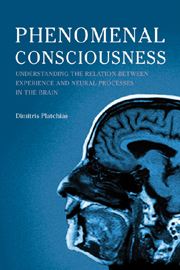Book contents
- Frontmatter
- Contents
- Acknowledgements
- Miscellaneous Frontmatter
- Introduction
- 1 The nature of the mind
- 2 Phenomenal consciousness: the hard problem
- 3 Phenomenal consciousness and the “sufficiency” claim
- 4 Experience and first-order representationalism
- 5 Experience and the explanatory gap
- 6 Experience and higher-order representationalism
- Notes
- Bibliography
- Index
2 - Phenomenal consciousness: the hard problem
- Frontmatter
- Contents
- Acknowledgements
- Miscellaneous Frontmatter
- Introduction
- 1 The nature of the mind
- 2 Phenomenal consciousness: the hard problem
- 3 Phenomenal consciousness and the “sufficiency” claim
- 4 Experience and first-order representationalism
- 5 Experience and the explanatory gap
- 6 Experience and higher-order representationalism
- Notes
- Bibliography
- Index
Summary
QUALIA
Imagine the best slice of pizza in the world: New York-style size, two thin and crispy crusts, with melted provolone and cheddar cheese, pizza sauce and toppings in between. Imagine you bite into the slice and taste its deliciousness. What is the underlying mechanism that enables you to taste the pizza? Contemporary neuroscience tells us that taste is a function of the central nervous system. It arises from the regions of the oral cavity and, in particular, from chemical changes in your taste buds, which are located on the upper surface of your tongue and the roof of your mouth. When these chemical changes occur, the taste receptor cells send information, that is electric signals, to the gustatory areas of the brain via a number of cranial nerves. This produces certain physical changes in that area of the brain and that enables you to taste the pizza.
Most people are not desperate to hear this story, although they might be desperate to taste the pizza. The taste of the pizza is one of the most familiar things in the world, but it is also one of the most mysterious. For what is taste and where is it? What magical thing happens when certain physical changes occur in the brain enabling you to taste the pizza? How can taste come as a result of nerve tissue excitation? It is incredibly hard to answer these questions. For as I argued in Chapter 1, it seems that even if a scientist scans your brain while eating the pizza, no matter how accurate the brain scanning is or whether he or she uses PET or fMRI scan, or even if the scientist uses a very advanced technique and painlessly cuts your brain open, he or she will not be able to spot the taste of pizza next to the grey mass of neurons. It seems that the taste is subjective, in the sense that it is not open to investigation from a third-person point of view. If so, then there is a real problem in accounting for the relation between the nerve tissue (objective property) and the taste (subjective property) that arises from its excitation.
- Type
- Chapter
- Information
- Phenomenal ConsciousnessUnderstanding the Relation between Neural Processes and Experience, pp. 49 - 64Publisher: Acumen PublishingPrint publication year: 2010

